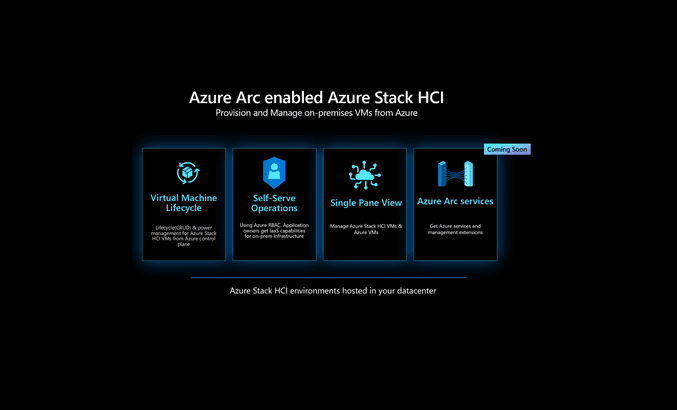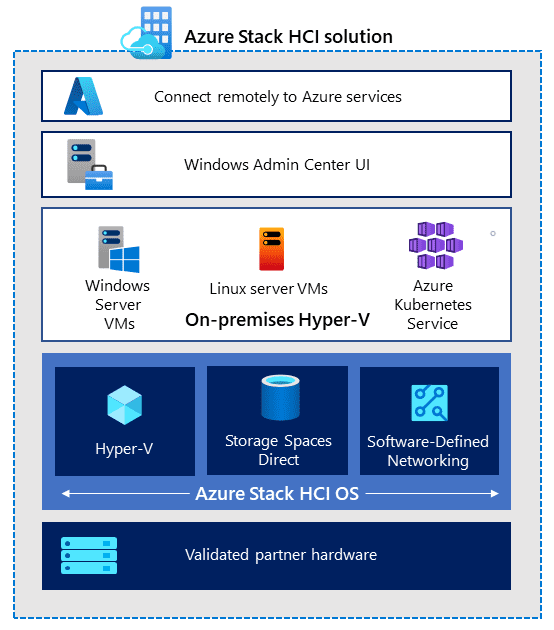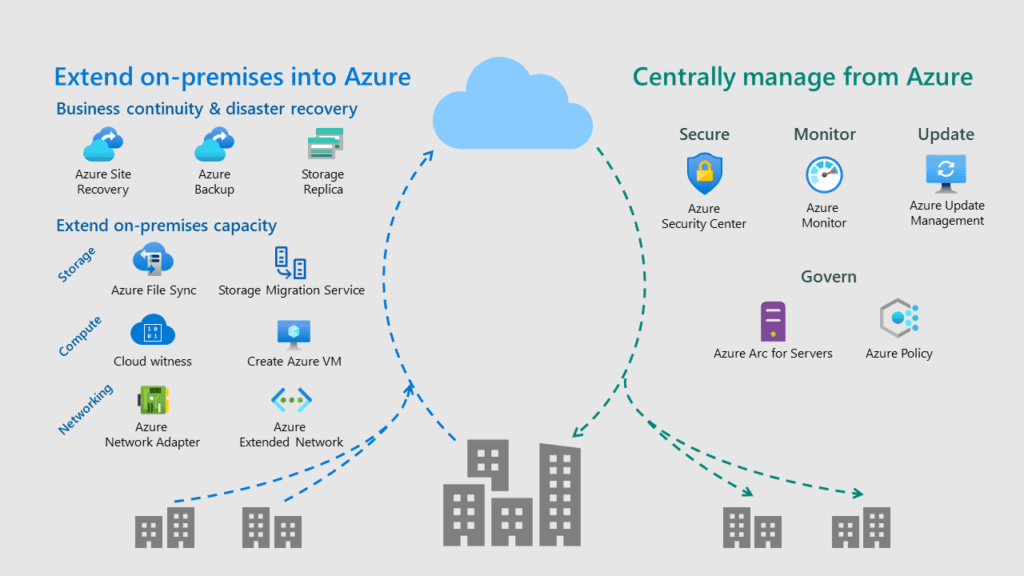
Learn more about Azure Stack HCI, a preconfigured, validated offering that enables you to deploy a cloud in your own datacenter.
What is Azure Stack HCI?
Microsoft Azure Stack HCI is a cluster solution, based on a hyperconverged infrastructure (HCI). It is designed to host virtualized Windows and Linux workloads and their storage in a hybrid environment. It bridges the gap between on-premises infrastructure and Azure cloud services.

Most apps and server roles must run inside of virtual machines (VMs) because Azure Stack HCI is intended as a virtualization host. There are exceptions: Hyper-V, Network Controller, and other components required for Software Defined Networking (SDN) or for the management and health of hosted VMs. There are many features and IT goals that you can accomplish with this solution, including enterprise virtualization, high availability, Microsoft SQL Server at scale, centralized and automated update management, central security updates, and many more!
Azure Stack HCI is a sea change in how to deploy a cloud
Over the past two years (and beyond…), the ‘customer reality’ is transforming. You know that digital transformation we consistently hear about? Yes. 90% of enterprises remain hybrid. 93% of enterprises have a multi-cloud strategy. Organizations have 100’s to 1000’s of apps amongst VMs, databases, containers, .NET applications, and on and on.
A diverse infrastructure consisting of datacenters, branch offices, OEM hardware, even IoT devices muddies the waters of having to maintain and support all this infrastructure. And on top of that, most companies are utilizing Microsoft Azure, AWS, Google Cloud, etc. Your teams are using various development tools.
Microsoft has long understood this reality. What’s ‘top of mind’ amongst Microsoft’s customers?
- “We want to manage our infrastructure at scale across distributed environments while ensuring security and compliance.”
- “We want to manage our cloud and on-premises infrastructure in a consistent way, leveraging our existing tools and skillset.”
- “We built cloud apps that now need to run on-premises and at the edge. We tried deploying and managing our own Kubernetes on-premises and it’s challenging. How do we do this?”
- “We want to reduce complexity with fewer moving parts. We need to deliver new applications and value faster.”

What is the difference between Azure Stack (Hub) and Azure Stack HCI?
As your organization continues its ‘digital transformation’, you may find it easier and faster to use public cloud services to build modern architecture and refresh legacy apps. However, you may indeed run into technological and regulatory obstacles; many workloads must, therefore, remain on-premises.
You can use the table below, as an example, to help you determine which Microsoft hybrid cloud strategy provides what you need where you need it.
Table 1 – Azure Stack HCI vs Azure Stack Hub
| Azure Stack HCI | Azure Stack Hub |
| Same skills, familiar processes | New skills, innovative processes |
| Azure services in your datacenter using Azure Arc | Azure services in your datacenter in disconnected scenarios |
| Connect your datacenter to Azure services and Azure control plane | Run your own instance of Azure Resource Manager |
| Flexible platform using integrated systems or validated nodes from OEMs | Delivered as an integrated system from OEMs |
Is Azure Stack HCI free?
No, Azure Stack HCI is not free. When purchasing this solution and accurately licensing it, you need to tie the Azure service and bill it to an existing (or new) Azure subscription. See below.
How to license Azure Stack HCI
Azure Stack HCI is an Azure service that goes on your Azure subscription bill just like any other Azure service. It’s priced on a per-core basis on your on-premises servers. For current pricing, see Azure Stack HCI pricing. You will get one unified, itemized bill at the end of the month. Many of the features of Azure Stack HCI (Azure Backup, Azure Monitor, Azure Security Center, etc.) are included in the base pricing model.
No traditional on-premises software license is required, although guest virtual machines (VMs) may require individual operating system licensing – see Activate Windows Server VMs. If the Azure Stack HCI is already an operational expenditure, we also invite you to read our Azure Stack HCI Pricing – Is Full OPEX Possible? post on Petri.
What are the deployment scenarios for Azure Stack HCI?
The high-level deployment scenarios for Azure Stack HCI are based on if you are going to download and install the Azure Stack HCI operating system on each of the servers you’ve purchased you want to cluster, or if they’ve been pre-installed through your preferred Microsoft hardware partner.
Microsoft recommends purchasing validated hardware and software solutions from their partners. These solutions are designed, assembled, and validated against reference architecture to ensure compatibility and reliability, to assist in your rollout timelines.
Check that the systems, components, devices, and drivers you are using are Windows Server 2019 Certified per the Windows Server Catalog. Visit the Azure Stack HCI solutions website for validated solutions, and you can also check out our separate guide on how to select hardware for Azure Stack HCI.
Before you deploy the Azure Stack HCI operating system:
- Plan your physical network requirements and host network requirements.
- If your deployment stretches across multiple sites, determine how many servers you will need at each site and whether the cluster configuration will be active/passive or active/active.
- Carefully choose drives and plan volumes to meet your storage performance and capacity requirements.
There may be additional requirements if you are planning to deploy Azure Kubernetes Service on Azure Stack HCI. Check our detailed guide explaining how to install Azure Stack HCI single-node clusters on Petri.
App consistency across on-premises and Microsoft Azure
Many organizations continue to require, for various reasons, their on-premises infrastructure. As you move forward with adding more cloud platforms and solutions to the mix, your on-premises datacenters often continue to play an important role.
The term hybrid cloud refers to a combination of public cloud and on-premises datacenters, to create an integrated IT environment that spans both. Some organizations use hybrid cloud as a path to migrate their entire datacenter to the cloud over time. Others use cloud services to extend their existing on-premises infrastructure.
Here’s where Azure Stack HCI comes in: for a complete hybrid cloud solution. Azure Stack HCI is a hybrid cloud platform that lets you provide Azure services from your datacenter. This helps maintain consistency between on-premises and Azure, by using identical tools and requiring no code changes.
The following are some use cases for Azure and Azure Stack HCI:
- Edge and disconnected solutions. Address latency and connectivity requirements by processing data locally in Azure Stack and then aggregating in Azure for further analytics, with common application logic across both.
- Cloud applications that meet varied regulations. Develop and deploy applications in Azure, with the flexibility to deploy the same applications on-premises on Azure Stack to meet regulatory or policy requirements.
- Cloud application model on-premises. Use Azure to update and extend existing applications or build new ones. Use consistent DevOps processes across Azure in the cloud and Azure Stack on-premises.
Admin consistency across on-premises and Microsoft Azure
The beauty, efficiency, and downright seamlessness Microsoft has created for allowing your IT admins to manage both on-premises Windows Servers AND Azure Stack HCI is in Windows Admin Center. It is a locally deployed, browser-based app for managing both ‘clouds’ together, and as one. The simplest way to install Windows Admin Center is on a local management PC (desktop mode), although you can also install it on a server (service mode).
If you install Windows Admin Center on a server, tasks that require CredSSP, such as cluster creation and installing updates and extensions, require using an account that’s a member of the Gateway Administrators group on the Windows Admin Center server.
Azure Stack HCI at scale
There are many ways the Azure Stack HCI portfolio solution can assist your organization to accomplish your IT goals at scale. Here are a few:
- Run workloads from your branch office to the edge – meet the evolving IT demands of branch offices, retail stores, and field locations at an affordable cost.
- Support large-scale virtual desktop infrastructure implementations (VDI) – use remote desktop services, highly available virtual machines (VMs), and integrated scalable storage to support your large-scale virtual implementations.
- Optimize the performance of virtualizing SQL Server – deploy and manage demanding SQL Server workloads running on hyperconverged infrastructure to get best of class performance.
- Deploy a tightly integrated Kubernetes-enabled platform – enable automated deployment and management of containerized apps by running Kubernetes clusters on your hyperconverged infrastructure.
Azure Stack HCI architecture
Azure Stack HCI is a world-class, integrated virtualization stack built on proven technologies that have already been deployed at scale, including Hyper-V, Storage Spaces Direct, and Azure-inspired SDN. It’s part of the Azure Stack family, using the same software-defined compute, storage, and networking software as Azure Stack Hub.

Each Azure Stack HCI cluster consists of between 2 and 16 physical, validated servers. The clustered servers share common configuration and resources by leveraging the Windows Server Failover Clustering feature.
Azure Stack HCI combines the following:
- Azure Stack HCI operating system
- Validated hardware from an OEM partner
- Azure hybrid services
- Windows Admin Center
- Hyper-V-based compute resources
- Storage Spaces Direct-based virtualized storage
- SDN-based virtualized networking using Network Controller (optional)
What are the hardware requirements for Azure Stack HCI?
A standard Azure Stack HCI cluster requires a minimum of two servers and a maximum of 16 servers; however, clusters can be combined using cluster sets to create an HCI platform of hundreds of nodes.
Keep the following in mind for various types of deployments:
- Stretched clusters require servers to be deployed at two separate sites. The sites can be in different countries, different cities, different floors, or different rooms. A stretched cluster requires a minimum of 4 servers (2 per site) and a maximum of 16 servers (8 per site).
- It’s required that all servers be the same manufacturer and model, using 64-bit Intel Nehalem grade, AMD EPYC grade, or later compatible processors with second-level address translation (SLAT). A second-generation Intel Xeon Scalable processor is required to support Intel Optane DC persistent memory. Processors must be at least 1.4 GHz and compatible with the x64 instruction set.
- Make sure that the servers are equipped with at least 32 GB of RAM per node to accommodate the server operating system, VMs, and other apps or workloads. In addition, allow 4 GB of RAM per terabyte (TB) of cache drive capacity on each server for Storage Spaces Direct metadata.
- Verify that virtualization support is turned on in the BIOS or UEFI:
- Hardware-assisted virtualization. This is available in processors that include a virtualization option, specifically processors with Intel Virtualization Technology (Intel VT) or AMD Virtualization (AMD-V) technology.
- Hardware-enforced Data Execution Prevention (DEP) must be available and enabled. For Intel systems, this is the XD bit (execute disable bit). For AMD systems, this is the NX bit (no execute bit).
- You can use any boot device supported by Windows Server, which now includes SATADOM. RAID 1 mirror is not required, but is supported for boot. A 200 GB minimum size is recommended.
- As of December 2021, Windows Server Hot Patching is now available for on-premises Azure Stack HCI.
- For additional feature-specific requirements for Hyper-V, see System requirements for Hyper-V on Windows Server.
Visit this Microsoft Documentation site for all the logical and system requirements.
Join the Azure Stack HCI preview channel
The Azure Stack HCI release preview channel is an opt-in program that lets customers install the next version of the operating system before it’s officially released. It’s intended for customers who want to evaluate new features, system architects who want to build a solution before conducting a broader deployment, or anyone who wants to see what’s coming next.
There are no program requirements or commitments. Preview builds are available via Windows Update using Windows Admin Center or PowerShell.
Related Articles:
- What are Azure ArcBox and Azure Stack HCI Jumpstart?
- Why You Should Have a Fabric Domain and Network for Azure Stack HCI
- Three Ways to Load Balance Applications Running on Azure Stack HCI
- What Are the Network Requirement Changes in Azure Stack HCI Version 22H2?
- Azure Stack HCI Deployment: Choosing Between Large Clusters vs. Smaller Specialized Clusters
Table of contents
- What is Azure Stack HCI?
- Azure Stack HCI is a sea change in how to deploy a cloud
- What is the difference between Azure Stack (Hub) and Azure Stack HCI?
- Is Azure Stack HCI free?
- How to license Azure Stack HCI
- What are the deployment scenarios for Azure Stack HCI?
- App consistency across on-premises and Microsoft Azure
- Admin consistency across on-premises and Microsoft Azure
- Azure Stack HCI at scale
- Azure Stack HCI architecture
- What are the hardware requirements for Azure Stack HCI?
- Join the Azure Stack HCI preview channel



